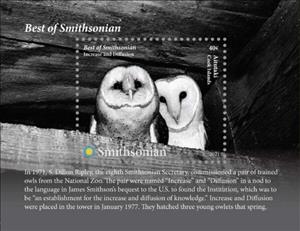Souvenir Sheet: Owls "Increase" and "Diffusion" (Aitutaki 2021)
Owls "Increase" and "Diffusion" (Aitutaki 2021)
01 January (Aitutaki ) within release The Best of the Smithsonian (2021) goes into circulation Souvenir Sheet Owls "Increase" and "Diffusion" face value 40 New Zealand cent
| Souvenir Sheet Owls "Increase" and "Diffusion" in catalogues | |
|---|---|
| Colnect codes: | Col: CK-AI 2021-04B |
Souvenir Sheet is square format.
Also in the issue The Best of the Smithsonian (2021):
- Souvenir Sheet - Arts and Industries Building face value 80;
- Souvenir Sheet - Katherine Dulin Folger Rose Garden face value 70;
- Souvenir Sheet - National Museum of the American Indian face value 90;
- Souvenir Sheet - Owls "Increase" and "Diffusion" face value 40;
- Souvenir Sheet - Steven F Udvar-Hazy Center face value 30;
- Souvenir Sheet - The Castle - Smithsonian Institution Administrative Building face value 50;
Souvenir Sheet Owls "Increase" and "Diffusion" it reflects the thematic directions:
Animals are multicellular, eukaryotic organisms of the kingdom Animalia (also called Metazoa). All animals are motile, meaning they can move spontaneously and independently, at some point in their lives. Their body plan eventually becomes fixed as they develop, although some undergo a process of metamorphosis later on in their lives. All animals are heterotrophs: they must ingest other organisms or their products for sustenance.
Birds (Aves), a subgroup of Reptiles, are the last living examples of Dinosaurs. They are a group of endothermic vertebrates, characterised by feathers, toothless beaked jaws, the laying of hard-shelled eggs, a high metabolic rate, a four-chambered heart, and a strong yet lightweight skeleton. Birds live worldwide and range in size from the 5 cm (2 in) bee hummingbird to the 2.75 m (9 ft) ostrich. They rank as the class of tetrapods with the most living species, at approximately ten thousand, with more than half of these being passerines, sometimes known as perching birds. Birds are the closest living relatives of crocodilians.
Birds of prey or predatory birds, also known as raptors, are hypercarnivorous bird species that actively hunt and feed on other vertebrates (mainly mammals, reptiles and smaller birds). In addition to speed and strength, these predators have keen eyesight for detecting prey from a distance or during flight, strong feet with sharp talons for grasping or killing prey, and powerful, curved beaks for tearing off flesh. Although predatory birds primarily hunt live prey, many species (such as fish eagles, vultures and condors) also scavenge and eat carrion
A museum (/mjuːˈziːəm/ mew-ZEE-əm) is an institution dedicated to displaying and/or preserving culturally or scientifically significant objects. Many museums have exhibitions of these objects on public display, and some have private collections that are used by researchers and specialists. Compared to a library, a museum hosts a much wider range of objects and usually focus around a specific theme such as the arts, science, natural history, local history, and other topics. Public museums that host exhibitions and interactive demonstrations are often considered to be tourist attractions, and many museums attract large numbers of visitors from outside their host country, with the most visited museums in the world regularly attracting millions of visitors annually.
Owls are birds from the order Strigiformes, which includes over 200 species of mostly solitary and nocturnal birds of prey typified by an upright stance, a large, broad head, binocular vision, binaural hearing, sharp talons, and feathers adapted for silent flight. Exceptions include the diurnal northern hawk-owl and the gregarious burrowing owl.





